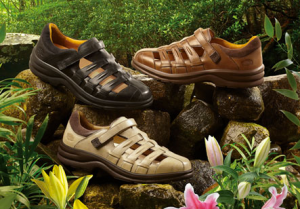Orthopaedic Shoes
Will Orthopaedic Shoes Help Me?
Supportive, well-fitting footwear plays a vital role in keeping you mobile and pain free.
However, wearing appropriate shoes is sometimes not enough if you have certain foot conditions and foot types. If this is the case, you may require orthopaedic shoes.
What are orthopaedic shoes?
Orthopaedic shoes are shoes that are specifically designed to support or accommodate the mechanics and structure of your foot, ankle and leg.
Do I need Orthopaedic shoes?
The more abnormal your foot mechanics are, the more likely you will require orthopaedic shoes. You may need orthopaedic shoes if you have:
- a foot or toe deformity
- a complicated or severe foot injury
- extremely wide feet or bunions
- an ulceration
- poor foot mechanics
- a neurological disease that affects your feet, such as diabetes
- a brace that requires specialized footwear to accommodate it.
If you think you may need orthopaedic footwear, book a consultation with us, a foot expert, to conduct a full assessment of your lower limbs and tell y ou which orthopaedic features you require for your foot type and condition.
Where can I purchase orthopaedic shoes?
Although some retail outlets specialize in hard to fit feet and orthopaedic shoes, orthopaedic footwear is usually found in stores and clinics that have a resident foot care specialist. A Pedorthist can adv ise you on the best orthopaedic shoes for you and make sure they fit your feet properly.
Do I need to wear my orthopaedic shoes all the time?
Depending on the shape of your feet and the nature of the condition you may need to wear your orthopaedic shoes most, if not, all of the time. However, some people need only wear their orthopaedic shoes while at work or when they are active or standing for a long period of time.
Are orthopaedic shoes just for seniors?
Nope. Although changes in foot structure and biomechanics associated with aging may require orthopaedic shoes, poor foot mechanics can affect peoples of any age. More stylish alternative exist than in the early days of orthopaedic footwear so we can usually accommodate your fashion tastes, as browsing through our products will show.
Are all orthopaedic shoes the same?
Nope. They come with a variety of different features to accommodate for various foot conditions and mechanics. We can help you navigate the options and find the footwear that will help your situation.
What orthopaedic features should I look for?
As stated above, orthopaedic shoes come with a variety of different features to accommodate various conditions and medical foot problems. All orthopaedic shoes have some, or all, of the following features and functions:
- Removable sock liner or insole — these removable footbeds allow for extra depth in the shoe to accommodate custom orthotics if you need them
- Adjustable closure — laces or Velcro are important to insure a secure fit for your shoes
- Variety of widths — a necessaty to ensure a proper fit for narrow, standard, wide and extra-wide feet. Half-sizes also make fitting easier and more accurate
- Appropriate heel counter — that back part of your shoe is very important depending on your medical need. A stiff heel counter will provide much needed stability and control excessive rolling inward/outward while soft heel counters would protect a sore bump on the back of your heel.
- Torsionally strong midsole and outsole — proper footwear should provide a stable base for the foot and not twist or bend easily in the midsole. This is an area to watch when purchasing footwear in general, as this is one area where some manufactures try to eliminate weight by carving out the arch under the foot. This also makes footwear appear slimmer. but not always desirable.


Post This!
Share this post with your friends!